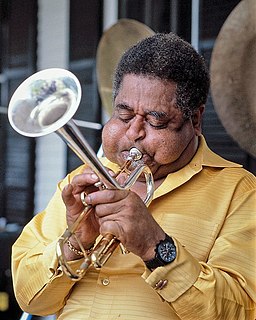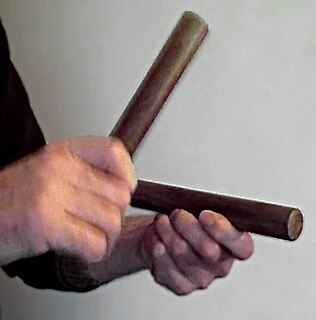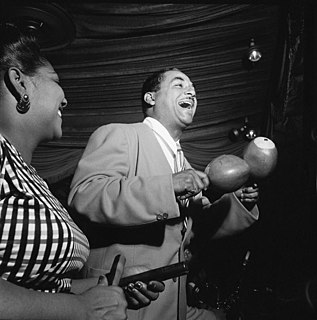Related Research Articles
Jazz is a music genre that originated in the African-American communities of New Orleans, Louisiana, United States, in the late 19th and early 20th centuries, with its roots in blues and ragtime. Since the 1920s Jazz Age, it has been recognized as a major form of musical expression in traditional and popular music, linked by the common bonds of African-American and European-American musical parentage. Jazz is characterized by swing and blue notes, complex chords, call and response vocals, polyrhythms and improvisation. Jazz has roots in West African cultural and musical expression, and in African-American music traditions.

John Birks "Dizzy" Gillespie was an American jazz trumpeter, bandleader, composer, educator and singer. He was a trumpet virtuoso and improviser, building on the virtuoso style of Roy Eldridge but adding layers of harmonic and rhythmic complexity previously unheard in jazz. His combination of musicianship, showmanship, and wit made him a leading popularizer of the new music called bebop. His beret and horn-rimmed spectacles, scat singing, bent horn, pouched cheeks, and light-hearted personality provided one of bebop's most prominent symbols.

Salsa music is a popular style of Latin American music. Because most of the basic musical components predate the labeling of salsa, there have been many controversies regarding its origin. Most songs considered as salsa are primarily based on son montuno, with elements of mambo, Latin jazz, bomba, plena and guaracha. All of these elements are adapted to fit the basic son montuno template when performed within the context of salsa.

Jazz fusion is a music genre that developed in the late 1960s when musicians combined jazz harmony and improvisation with rock music, funk, and rhythm and blues. Electric guitars, amplifiers, and keyboards that were popular in rock and roll started to be used by jazz musicians, particularly those who had grown up listening to rock and roll.

The clave is a rhythmic pattern used as a tool for temporal organization in Afro-Cuban music. In Spanish, clave literally means key, clef, code, or keystone. It is present in a variety of genres such as Abakuá music, rumba, conga, son, mambo, salsa, songo, timba and Afro-Cuban jazz. The five-stroke clave pattern represents the structural core of many Afro-Cuban rhythms.
Latin jazz is a genre of jazz with Latin American rhythms. The two main categories are Afro-Cuban jazz, rhythmically based on Cuban popular dance music, with a rhythm section employing ostinato patterns or a clave, and Afro-Brazilian jazz, which includes samba and bossa nova.

Callen Radcliffe Tjader Jr. was an American Latin jazz musician, known as the most successful non-Latino Latin musician. He explored other jazz idioms, even as he continued to perform the music of Cuba, the Caribbean, Mexico and Latin America.

The conga, also known as tumbadora, is a tall, narrow, single-headed drum from Cuba. Congas are staved like barrels and classified into three types: quinto, tres dos or tres golpes (middle), and tumba or salidor (lowest). Congas were originally used in Afro-Cuban music genres such as conga and rumba, where each drummer would play a single drum. Following numerous innovations in conga drumming and construction during the mid-20th century, as well as its internationalization, it became increasingly common for drummers to play two or three drums. Congas have become a popular instrument in many forms of Latin music such as son, descarga, Afro-Cuban jazz, salsa, songo, merengue and Latin rock.
Afro-Cuban jazz is the earliest form of Latin jazz. It mixes Afro-Cuban clave-based rhythms with jazz harmonies and techniques of improvisation. Afro-Cuban jazz emerged in the early 1940s with the Cuban musicians Mario Bauzá and Frank Grillo "Machito" in the band Machito and his Afro-Cubans in New York City. In 1947, the collaborations of bebop trumpeter Dizzy Gillespie and percussionist Chano Pozo brought Afro-Cuban rhythms and instruments, such as the tumbadora and the bongo, into the East Coast jazz scene. Early combinations of jazz with Cuban music, such as "Manteca" and "Mangó Mangüé", were commonly referred to as "Cubop" for Cuban bebop.

Machito was a Latin jazz musician who helped refine Afro-Cuban jazz and create both Cubop and salsa music. He was raised in Havana with the singer Graciela, his foster sister.

Prudencio Mario Bauzá Cárdenas was an Afro-Cuban jazz, Latin, and jazz musician. He was among the first to introduce Cuban music to the United States by bringing Cuban musical styles to the New York City jazz scene. While Cuban bands had had popular jazz tunes in their repertoire for years, Bauzá's composition "Tangá" was the first piece to blend jazz harmony and arranging technique, with jazz soloists and Afro-Cuban rhythms. It is considered the first true Afro-Cuban jazz or Latin jazz tune.
Scott Yanow is an American jazz reviewer, historian, and author.
Michele Rosewoman is an American jazz pianist who leads the big band New Yor-Uba. She has worked with Baikida Carroll, Julius Hemphill, Julian Priester, Oliver Lake, Billy Bang, Freddie Waits, Rufus Reid, Billy Hart, Reggie Workman, Celia Cruz, Chocolate Armenteros, and Paquito D'Rivera.
Edward Cano was an Afro-Cuban jazz and Latin jazz pianist and composer.

The Amazing Bud Powell, also called The Amazing Bud Powell, Vol. 1, is an album by jazz pianist Bud Powell, first released on Blue Note in April 1952, as a 10" vinyl. It is part of a loosely connected series with the 1954 companion The Amazing Bud Powell, Vol. 2 and the 1957 Bud! The Amazing Bud Powell , all released on Blue Note. The album details two recording sessions. In the first, recorded on August 9, 1949, Powell performed in quintet with Fats Navarro, Sonny Rollins, Tommy Potter and Roy Haynes, and in trio with Potter and Haynes. In the second, on May 1, 1951, Powell performed in trio with Curley Russell and Max Roach, and solo.
Carlos Emilio Morales was a Cuban jazz guitarist.
A guajeo is a typical Cuban ostinato melody, most often consisting of arpeggiated chords in syncopated patterns. Some musicians only use the term guajeo for ostinato patterns played specifically by a tres, piano, an instrument of the violin family, or saxophones. Piano guajeos are one of the most recognizable elements of modern-day salsa. Piano guajeos are also known as montunos in North America, or tumbaos in the contemporary Cuban dance music timba.
Tresillo is a rhythmic pattern used in Latin American music. It is a more basic form of the rhythmic figure known as the habanera.

Afro-Jaws is an album by saxophonist Eddie "Lockjaw" Davis recorded in 1960 and released on the Riverside label.
Great Guitars was a supergroup formed by jazz guitarists Charlie Byrd, Herb Ellis, and Barney Kessel in 1973.
References
- ↑ Erika Alexia Tsoukanelis (August 1, 2009). The Latin Music Scene: The Stars, the Fans, the Music. Enslow Publishers, Inc. p. 41. ISBN 978-0-7660-3399-3 . Retrieved November 21, 2015.
- ↑ Silvio H. Alava (2007) "Spanish Harlem's Musical Legacy", ISBN 0-7385-5006-X, Foreword
- ↑ "LBMO.com - Latin Beat Magazine - Latin Music Magazine". latinbeatmagazine.com.
- ↑ Yanow, Scott (2000). Afro-Cuban Jazz: Third Ear - the Essential Listening Companion. ISBN 0-87930-619-X.